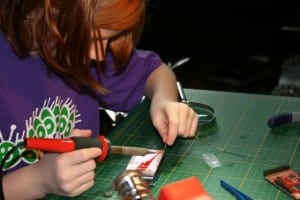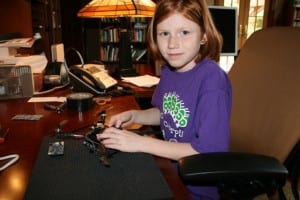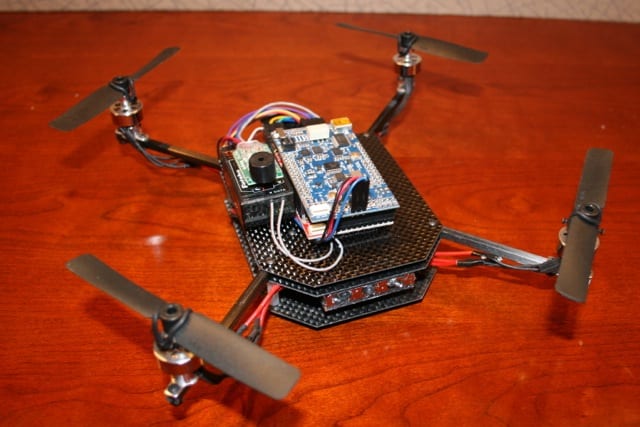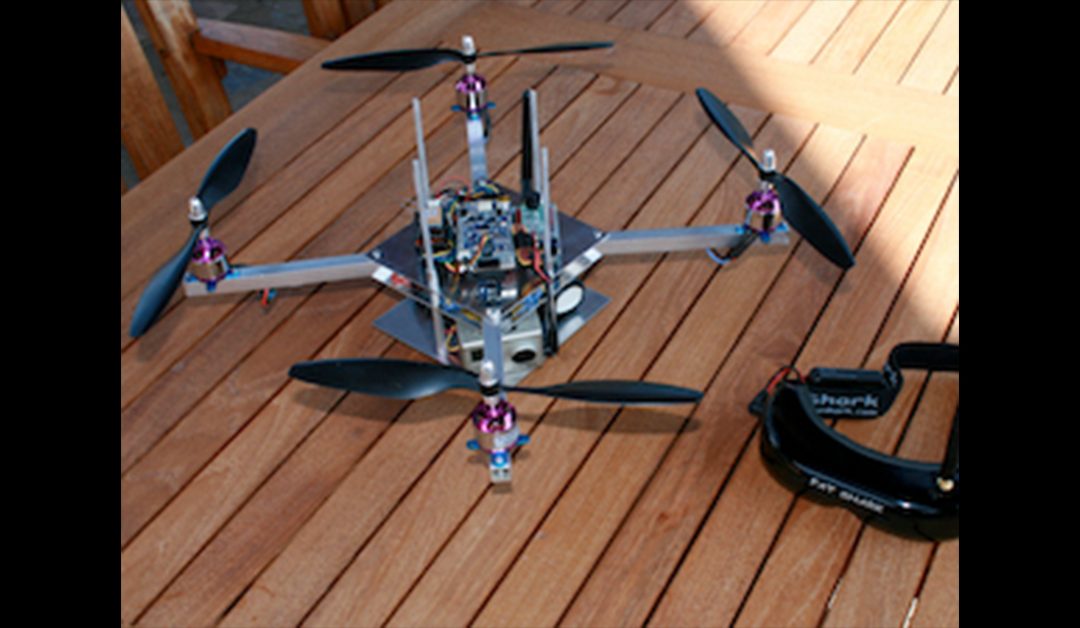
by Camille | Workshop Blog
Today, we upgraded our little mini quad rotor flying drone that we call “The Black Hornet.”
We replaced his main board, installed new propellers, re-fixtured his motor mounts, and got him in good flying shape. He flew steady and strong in our test flights.

Genevieve soldering the main circuit board for the Black Hornet

Genevieve connecting electronics on the Black Hornet mini quad rotor

Genevieve finalizing the upgrades on the Black Hornet mini drone

The fully-upgraded Black Hornet mini drone

by Camille | Robots, Workshop Blog
After building our first Arduino-based flying drone robot, we decided to take what we learned and build a tiny quadrotor that was safe to fly indoors and out. We used the same electronics, but built the frame out of ABS sheet and kite parts. This little robot, which we call the Black Hornet, is about 7″ across between the props. He’s great fun to fly day or night (he’s equipped with two arrays of cool blue LEDs), and definitely sounds like a huge hornet.

The Black Hornet mini drone
The Mini Flying Drone has since been upgraded with an all new frame design based on a sandwich of three custom-made carbon fiber plates and four carbon fiber square shafts.

Workshop Blog post on recent upgrade
Technical Specifics
See Flying Drone Robot page for details
Special Thanks to Jose Julio at DIY Drones for his knowledge and inspirational posting.

by Camille | Robots, Slider, Workshop Blog
We would like to introduce our flying drone robot. We can fly this robot using Remote Control or it can fly itself using sonar, an on-board GPS, and following longitude/latitude waypoints. We have experimented with various frame designs and electronics, so you’ll see some variation in the pictures. Be sure to check out the video of of me piloting the flying robot.

How We Came To Build a Flying Robot Drone
One day, we asked ourselves, “What kind of robot would you like to build next?”
We both answered, “I want to build a robot that flies!”
We knew it was going to be really hard, but we decided to give it a try. We set out to learn what it was going to take to build a robot that flies. We researched our options, purchased the various motors, propellers, and electronic components we thought we needed, and started soldering. As our initial design came together, we began cutting, drilling, and assembling the various aluminum pieces for the frame, which we knew would have to be both light and strong.
The Features and Design
We decided on a quad rotor design, which is a helicopter-like-thing with four propellers. The left and right motors use normal “puller” propellers and turn counter-clockwise. The front and back motors use “pusher” propellers and turn clockwise. This helps counter-act the torsional forces associated with rotor craft.
The core of the robot’s electronics is a special Arduino microcontroller board specifically designed for auto-piloting drones. This is combined with a special Inertial Measurement Unit (IMU) sensor shield that provides a 3-axis gyro, 3-axis accelerometer, barometric pressure, and other various other avionics sensors so that the robot can sense its tilt, pitch, and yaw in three-dimensional space at all times. The software reads the robots orientation and feeds voltage to each of the motors in proportion to the power that is needed to keep the robot level at all times. This way, the pilot focuses on the direction and speed he wants to go, rather than spending all his time struggling to keep the robot from flipping, spinning, or rolling.
Once we flew and crashed our first design, we made some improvements and tried again. Then we crashed again, made some more improvements, and so on. None of our robots have required more trial and error than this one. But step by step, improvement after improvement, our robot got better and better. Today, it flies very well, has many neat features, and thanks to repeated practice, is relatively crash resistant.
We usually fly the robot using an RC Transmitter. However, it also has many autopilot drone features that we enjoy experimenting with. For example, the robot has an automatic take-off and landing sequence. The robot also includes a downward-facing sonar so that the robot knows its exact altitude at all times. By flipping a switch on our transmitter, we can put the robot in “hold altitude” mode, which tells the robot to automatically and constantly adjust the motors to remain at a constant distance from the ground as we fly it around.The robot is also equipped with a GPS chip so that it knows its exact longitude and latitude at all times. The robot can also follow a series of waypoints uploaded to the microcontroller from Google Earth. It turns out that we were not the only ones trying to build a robot that flies. We have joined with a whole community of people on the Internet (DIY Drones) who enjoy building and flying their own robot drones.
The Mini Flying Drone
We have also built a Mini Flying Drone. Click here to see details.

Mini Quadrotor Drone Robot

The upgraded Black Hornet mini drone
The Future
Although our drones are flying quite well, there is still plenty more we want to do. We look forward to lots of fun and experimentation. We’ve spent most our time building, flying, and improving the robot’s frame and capabilities, but in the future we hope to do more with First Person View (FPV) flying using our video goggles, high-definition arial photography, automatic navigation, and more.
Click here to see our latest flying robot drone, which we made out of carbon fiber.
Flying Drone Robot – Technical Specifics
- Aluminum Frame: Beatty Robotics
- Aluminum, Hardware, and other materials: McMaster-Carr
- Microcontroller: ArduPilot Mega (i.e. Arduino Mega Autopilot board)
- Avionics sensor board: ArduPilot Mega IMU Shield
- Electronic Speed Controllers: (4) m2mPower
- Motors:(4) jDrones
- Propellers: (4) EPP 10×45
- Radio Control Transmitter and Receiver: Futaba
- Battery: 12v 3-cell 20C LIPO
- Magnetomer: DIY Drones
- GPS: MediaTek
- High Definition Camera: GoPro
- VideoTransmitter: ImmersionRC
- FPV Video Goggles: FatShark
Special thanks to the Do-It-Yourself Drones community, especially Chris Anderson, Jani Hirvinen, and the other guys involved with DIY Drones. You guys helped us make our dream of a flying robot a reality. Fly on!










